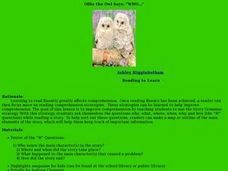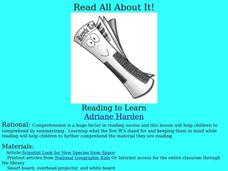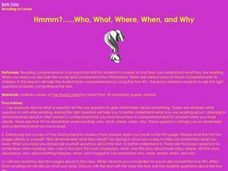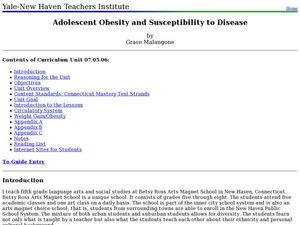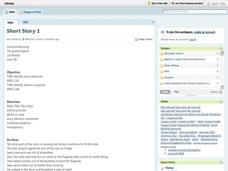Curated OER
The 5 W's
Examine how to answer who, what, when, where, and why when reading text. Young writers listen to the story Skeleton Hiccups, and as a class answer and discuss the five W's. Independently they read the story silently, and write the...
Curated OER
Ollie the Own Says: WHO
Scholars examine the strategy of making a story map or outline to identify the main elements of a story. They discuss the who, what, where, when, why, and how of a story, in an outline form. As a class they read a short story, answer the...
Curated OER
Comprehending Through Questioning
Elementary schoolers observe and apply a variety of reading comprehension strategies. They silently read a passage out of their science textbook, and discuss answering the who, what, where, when, and how of the text. In small groups they...
Curated OER
The 5 W's of Reading
Primary young scholars will use the five "W" questions for reading comprehension as they read silently to themselves so that they can understand and remember what they have read. They then read The Velveteen Rabbit aloud, discussing the...
Curated OER
The Five W's!
Students explore reading comprehension strategies. They discuss the story-grammar strategy. Students discuss the importance of comprehension. They discuss questions they should ask while reading a text. Students read a story and stop to...
Curated OER
Five Big W's
Students develop summarization strategies by asking themselves questions as they read. They devlop these strategies help them develop better comprehension. Students goals for reading is comprehension. They explore helpful...
Curated OER
Sum It Up !!
Students practice various comprehension strategies to generate the main idea of the text. They encounter unfamiliar concepts and new vocabulary in their quest of the main idea in "Watson's Goes to Burmingham." The Five W's (What, Where,...
Curated OER
Summing It All Up in a Nutshell
Students observe and demonstrate a variety of summarization strategies. They discuss the process of asking the five W questions, and apply then to a passage from the book "Sarah Plain and Tall." Students then finish the chapter from...
Curated OER
Reader R.E.A.C.T.I.O.N.
Learners practice their reading comprehension skills. In this reading skills lesson, students use the R.E.A.C.T.I.O.N. model to identify story elements in books that learners elect to read independently.
Curated OER
Read All About It!
Students are taught the comprehensions aids them in their reading and will make reading seem easier once they know what they are reading about. They access how th ask themselves the five W's: who, what, where, when, and why. Students by...
Curated OER
Hmmm...Who, What, Where, When, and Why
Young scholars practice reading comprehension by answering the 5 "W" questions. After reading "The Kissing Hand," they complete a class discussion addressing the questions who, what, when, where, and why. Students choose an...
Curated OER
Chinese Zodiac
Fifth graders identify the basic elements of a narrative story, such as the beginning, middle, and the end; to analyze the character traits in the story to write a summary using the 5 Ws and How chart included; through sample stories...
Curated OER
Living Longer
Students relate health information text to themselves and society. In this health information lesson, students answer questions using the 5 W's based on the health issue they are reading about. Students discuss life...
Curated OER
Summarization Safari
Young scholars summarize a piece of fiction text. After reviewing the correct way to question while reading, students independently read a short story. They complete a summary organizer using the five Ws outlined by the instructor during...
Curated OER
It's Raining Meatballs
Students observe and demonstrate the process of summarization using the book "Cloudy With a Chance of Meatballs" by Judi Barrett. They silently read the story, and as a class discuss the five W's. Students then write a short summary of...
Curated OER
Summarization
Pupils summarize a selected piece of text using the five Ws. After reviewing the correct way to read silently, students read a selected piece of nonfiction text. They write a summary paragraph using a process outlined by the instructor.
Curated OER
Adolescent Obesity and Susceptibility to Disease
Students understand the importance of maintaining a healthy weight and good health. In this health instructional activity students read text then create their own pamphlet on the cardiovascular system, weight gain, treatments and...
Curated OER
Do You want? Do You Like? There is/ There are
Students understand and recognize the names of various foods. In this food bingo lesson plan, students work in pairs to practice questioning with the phrases: do you want and do you like. Students practice listening and speaking skills...
Curated OER
Fish Counting Nursery Rhyme
Students experience The Fish Counting Rhyme. In this counting lesson, students practice counting while listening to The Fish Counting Rhyme.
Curated OER
The Name Jar
Students participate in a lesson that focuses on the literature of Korea. "The Name Jar" is read by students to practice some essential reading skills. This would include the recognition of sequence in a story, characterization, and...
Curated OER
Short Story
Seventh graders identify the various elements of a short story. After reading Rudyard Kipling's short story, "Rikki-Tikki-Tavi," students identify the author's purpose in writing the story as well as the elements that make it a short...
Curated OER
It's Raining Cats and Dog: Studying Idioms
Seventh graders determine the literal and figurative meanings of idioms and research the history of idioms. In this idioms activity, 7th graders read two books by Fred Gwynne and select two idioms from the texts to research. Students...
Curated OER
Short Story 2
Seventh graders review previous reading of Rikki Tikki Tavi. They discuss prior knowledge of simile, metaphor, idiom, and hyperbole. Students practice using vocabulary words from the story by listing synonyms for them. Students read from...
Curated OER
Class Field Guide to the Sloughs
Young scholars explore how to use field guides to identify wildlife. In this nature lesson plan students construct their own plant field guide.

